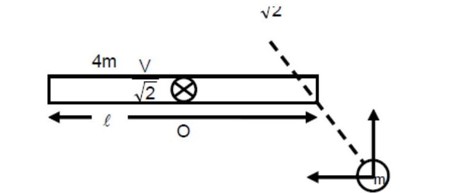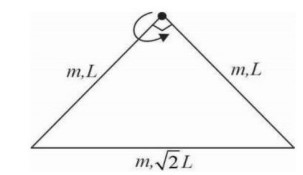Consider a uniform rod of mass
and length
pivoted about its centre. A mass
moving with velocity
making angle
to the rod's long axis collides with one end the rod and sticks to it. The angular sped of the rod-mass system just after the collision is
Consider a uniform rod of mass and length pivoted about its centre. A mass moving with velocity making angle to the rod's long axis collides with one end the rod and sticks to it. The angular sped of the rod-mass system just after the collision is
Option 1 -
Option 2 -
Option 3 -
Option 4 -
-
1 Answer
-
Correct Option - 2
Detailed Solution:
Similar Questions for you
L = Iω
I = (mL²/3) + (mL²/3) + [m (√2L)²/12] + m (L/√2)² = mL² [2/3 + 1/6 + 1/2] = (4mL²/3); L = (4/3)mL²ω
Yes, an object moving in a straight path can also possess angular momentum with respect to a referenc epoint which doesn't lie on it's path. In such cases. the referenc epoint may lie perpendicular distance from the axis. If an object is moving in a straight line (not through the reference point) the perpendicular distance (l = rp) will be non-zero.
Yes, how much time these planets take in completing an orbit around the sun hugely depends on their distance from the sun as well as their mass. Since these planets move in a circular orbit, the term angular momentum is used in such cases for computing relevant information.
Angular momentum also depends on how the mass is spread over the body and not just mass only. If you closely look at the formula of angular momentum:
L=r*p
You will observe that it is a cross product of two vector quantities. Hence, the formula won't be practical without direction being involved.
Taking an Exam? Selecting a College?
Get authentic answers from experts, students and alumni that you won't find anywhere else
Sign Up on ShikshaOn Shiksha, get access to
- 66k Colleges
- 1.2k Exams
- 680k Reviews
- 1800k Answers

